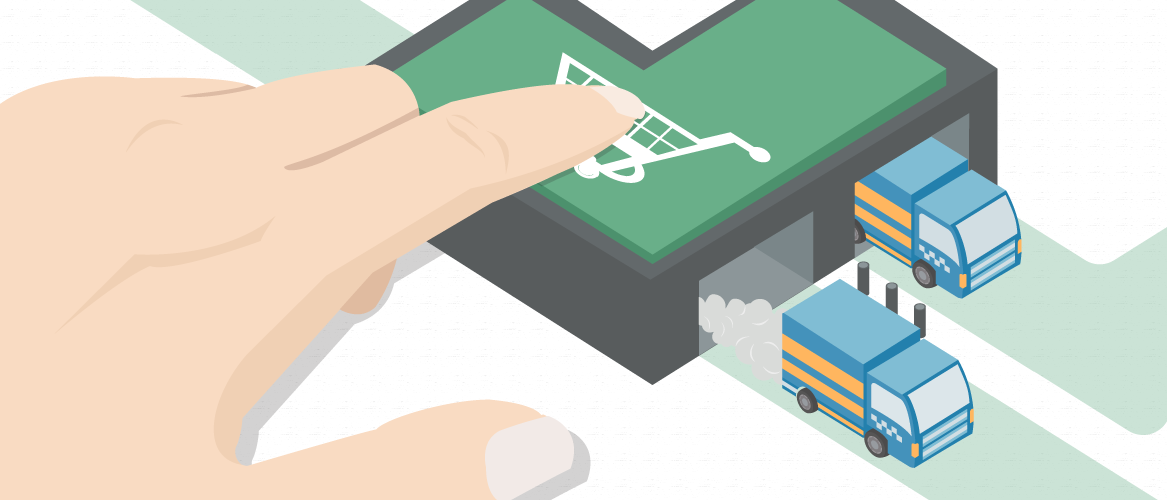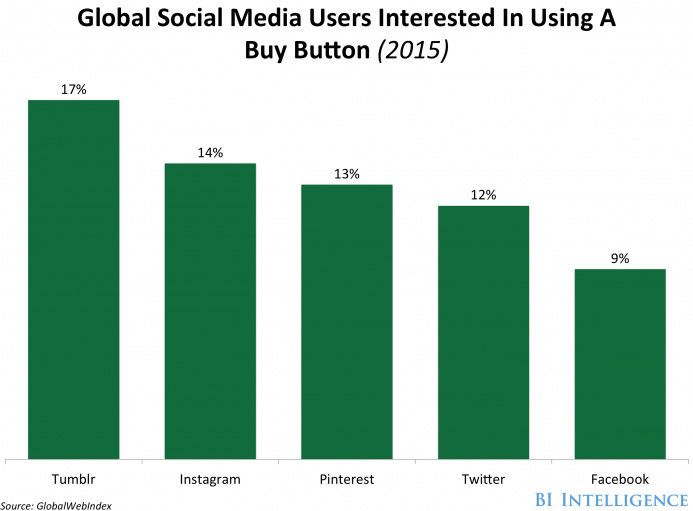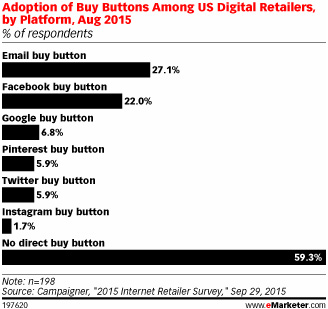Social buy buttons look pretty cool from an e-tailer’s point of view. They offer you the chance to take channels like Instagram, Twitter and the mighty Pinterest and cut out a couple of big funnel stages.
‘From a standpoint of an ad placed on a site like Facebook or Twitter that then requires someone to click off of that site and go into a retailer’s e-commerce site in order to complete the transaction, everyone of those steps in an opportunity for drop off,’ observes Gartner analyst Jennifer Polk.
That’s the appeal of social buy buttons: Instead of getting people to come from your social channel to your website and then to your cart and then buy, you can just sell right to them in social. Perfect.
But it hasn’t really worked out that way.
Instead, the number of buy buttons has exploded – it’s hard to find a social channel that doesn’t offer one. But they’re not moving the needle on sales the way they were supposed to.
So how should e-tailers approach them?
First: what do you need to know about social buy buttons?
Social Buy Buttons: The Story So Far
Social buy buttons generated a lot of excitement among marketers who saw a whole new paradigm emerging: social commerce was going to be the wave of the future. Small businesses especially were going to see sales facilitated as their social followings leaped straight to purchase. And social channels saw potential in moving e-commerce onto their channels and into their owned apps. Some take a percentage; others, like Pinterest, plan to profit from a rise in paid ads like Promoted Pins.
‘The goal for all our commerce initiatives on Twitter is simple: make it as easy as possible for businesses to connect directly with, and sell to, customers on Twitter,’ says Nathan Hubbard, Twitter’s head of commerce. ‘With Buy Now, businesses can drive more conversions and remove much of the friction in the mobile purchasing process.
But users don’t like them.
Buy Buttons and Users
Only 17% of Tumblr users are interested in using social buy buttons, and they’re the most enthusiastic group.
The picture gets worse when you think that Tumblr is mainly a desktop channel while other social channels are increasingly mobile-oriented, meaning that social buy buttons are failing to make the transition to mobile that still eludes the majority of e-tailers.
And among the most web-savvy group with significant cash to spend, millennials, interest was higher- but still not high enough. Only 35% of Millennials said they were interested in using social buy buttons on Facebook – and only 24% would use them on Twitter.
But there’s another way to look at these figures. Shopping cart abandonment is high among desktop users. Among mobile users, it’s very high – 97% on average.That would put non-social buying at 3% in the chart above, meaning all social buy options actually outstripped website purchase in terms of popularity. Granted, that still doesn’t mean buy buttons are the answer to the mobile conversion gap. But buy buttons aren’t disliked – people just aren’t responding to them.
Buy Buttons and Brands
Among US e-tailers, 59% haven’t adopted social buy buttons at all. By far the largest cohort of buy button adopters at 27% use email buy buttons, which remain on an owned and branded asset. Facebook came in second with a 22% adoption rate; Instagram, which at first glance seems like a natural for social buying, had a 1.7% adoption rate.
Facebook was the channel that generated the most sales, according to Emarketer, with 64% of social purchases coming through the channel; meanwhile just 5% of sales came from Pinterest.
Why Aren’t Buy Buttons Getting Any Traction?
Content
There’s a huge amount of content available on social channels. The better a fit a channel is for your audience, the more likely it is that your buy buttons are getting lost in the noise. The majority of content that actually gets shared doesn’t come from branded pins but from user-generated content, meaning that buttoned Pins and posts don’t get seen as much as e-tailers wish they did.
‘On Pinterest, the intersection between what people want to buy and what is available to buy is huge,’ says Sucharita Mulpuru, principal analyst for Forrester. ‘The majority of most popular pins are not buyable.’
Trust
Users don’t trust social – it’s seen as open, unsupervised, and therefore unsafe in a way that Amazon isn’t. And people are used to buying through e-commerce giants. Using your social payment button leaves customers wondering who’s guaranteeing their credit card details don’t fall into the wrong hands.
Mindset
Social buy buttons don’t fit into the social media mindset. They’re offering something that people want – they just don’t want it on their social feeds.
Gideon Lask, CEO of social commerce tech company BuyaPowa, says social should be thought of more as a state of mind than a destination, and buy buttons just don’t resonate.
‘We now spend 80 percent of our non-work online time being social – we are connected to people. We are minded to share, so how does a retailer tap into that connectivity mindset? Simply putting a buy button on a Pinterest page or an Instagram feed doesn’t do that remotely.’
Kirsten Newbold-Knipp, a research director at Gartner, agrees. Social is ‘is a different discovery vehicle than Amazon,’ she argues. ‘It’s about serendipity.’
Where Now for Buy Buttons?
Buy buttons might just be ahead of their time. We might be looking at a long ramp, not a flop – buy buttons are working, they’re just not transfiguring e-commerce like the hype said they would.
If you choose to use buy buttons, start with a hard push to build your social audience. Don’t expect immediate spectacular results from your buttons. Instead, view them as a source of data and a chance to gain the benefits of early adoption.
The best social channel for buy buttons right now is Facebook. That;’s not because everyone else has gotten the best results there. It’s because Facebook gives you the type of audience you need if you want to get sales, not just likes. Facebook’s Custom Audiences means you can design posts specifically for audiences based on things like their purchase histories and interests, allowing an advertising tool to become a great way to deliver buyable posts to your audience.
Facebook also allows you to work around one of the biggest obstacles to buy-button success: isolated buyable posts don’t offer readers the chance to assess your brand the way they’re used to. There’s no opportunity to learn your brand story, or to explore your site and learn to trust you. Facebook offers audience members the chance to overcome this by having one of the most segmented and stable audiences of any social channel.
If you don’t want to use buy buttons in straight-up social networks, try implementing them in email. Email is already super segmented, permission based and gives awesome ROI. Building buy buttons into post purchase, cross-sell and upsell email workflows can be an effective way to generate more sales. It also gives you access to users with a higher than average CLV, rather than the lower than Average CLV that, say, Twitter users have. 22% of a 500-marketer sample survey from Campaigner had already begun using buy buttons this year, with 22.3% planning to follow them; 36% of marketers who used email buy buttons reported an uptick in both sales and revenue.
A New Approach
Part of what holds back buy buttons is the approach brands take to their social channels. Persuading CXOs that social media was worth using as a marketing channel was always hard when there was little measurable ROI. No sooner have marketers gotten their heads around audience building, engagement and all the other ideas that characterize social marketing than organic reach nosedives – and the chance to actually make some cash on these channels creates a whole new level of confusion.
‘If social is looked after by brand creative people it’s just written off as something fluffy,’ argues BuyaPowa’s Gideon Lask, ‘and if the trading people look after it, it’s just used as a hard acquisition channel.’
So what should brands do?
‘Actually it’s a hybrid, just as email was a hybrid.’
You should also be prepared to bide your time.
‘The move from social media outlets to e-commerce is no small feat [but] it will probably take three to five years to become widely accepted,’ says Joshua Keller, chief executive officer of Union Square Media.
The future might see increased uptake on social buttons. Compare social buy buttons with e-commerce now, and they woefully underperform.
Compare them with e-commerce in its first years: the adoption rates look pretty similar, but e-commerce now accounts for 8% of all retail sales, up from 2.5% in 2006.
That shift is down to consumers becoming more confident and feeling safer spending money online. It’s not internet access per se that’s reflected in those statistics, but growing consumer acceptance of the idea of buying online.
‘While users are becoming more educated on direct purchasing from social media platforms, there may be an eventual shift that makes buy buttons as well-known as the like button. As with any change, it will take time for users to adjust,’ Joshua Keller points out.
About The Author:
Richard Bayston is a freelance blogger and copywriter covering tech, digital marketing and content strategy for SMBs. I’ve also been known to write on health and fitness. Find out more: Richard@RBCopywriting.com or @RBCopywriting. The rest of my time is spent arguing amicably with my wife and Googling the answers.
*Featured Image Source






